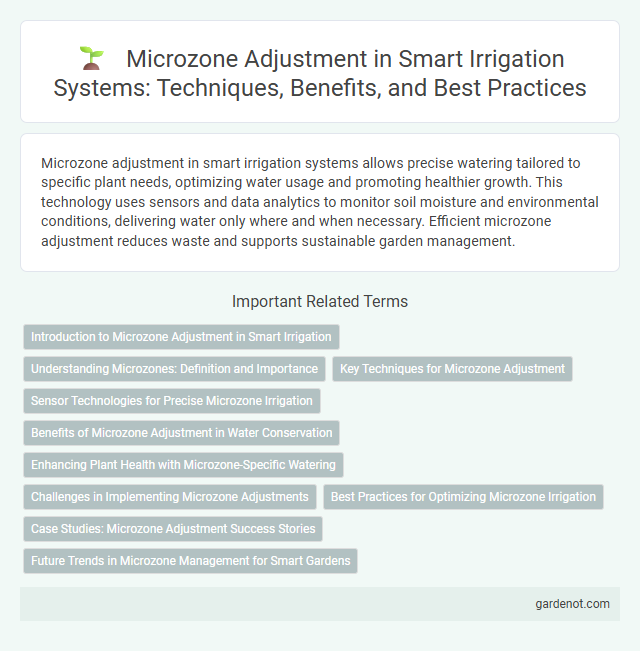Microzone adjustment in smart irrigation systems allows precise watering tailored to specific plant needs, optimizing water usage and promoting healthier growth. This technology uses sensors and data analytics to monitor soil moisture and environmental conditions, delivering water only where and when necessary. Efficient microzone adjustment reduces waste and supports sustainable garden management.
Introduction to Microzone Adjustment in Smart Irrigation
Microzone adjustment in smart irrigation enables precise watering by dividing landscapes into smaller, manageable zones based on specific plant requirements, soil types, and sun exposure. This targeted approach optimizes water usage, reduces waste, and promotes healthier plant growth by delivering the right amount of moisture to each microzone. Advanced sensors and smart controllers analyze real-time data to dynamically modify irrigation schedules, ensuring efficient water distribution tailored to microzone conditions.
Understanding Microzones: Definition and Importance
Microzone adjustment in smart irrigation involves tailoring water delivery to specific small-scale areas within a larger irrigation zone to address variations in soil type, plant species, and sunlight exposure. Understanding microzones is crucial as it enhances water efficiency by preventing overwatering or underwatering distinct areas, promoting healthier plant growth and conserving water resources. Precise microzone management leverages soil moisture sensors and advanced irrigation controllers to optimize water distribution based on real-time environmental data.
Key Techniques for Microzone Adjustment
Microzone adjustment in smart irrigation employs precise soil moisture sensors, variable flow control valves, and localized weather data to optimize water distribution. Techniques such as real-time soil moisture monitoring and automatic valve modulation enable targeted irrigation tailored to plant-specific water requirements. Integration of remote sensing and AI-based predictive analytics enhances microzone-specific watering schedules, minimizing water waste while promoting crop health.
Sensor Technologies for Precise Microzone Irrigation
Sensor technologies such as soil moisture sensors, weather stations, and evapotranspiration (ET) sensors enable precise microzone irrigation by providing real-time, localized data that adjusts water application to plant-specific needs. These sensors help optimize water efficiency by detecting exact moisture levels and environmental conditions, reducing over-irrigation and runoff. Implementing microzone-specific sensor data enhances crop health, conserves water resources, and supports sustainable agricultural practices.
Benefits of Microzone Adjustment in Water Conservation
Microzone adjustment in smart irrigation enables precise water delivery tailored to specific plant needs, reducing water waste by targeting root zones with optimal moisture levels. This technology enhances crop health and yield by preventing overwatering and underwatering, leading to efficient resource use. Implementing microzone adjustment can reduce overall water consumption by up to 30%, contributing significantly to sustainable water management in agriculture.
Enhancing Plant Health with Microzone-Specific Watering
Microzone adjustment in smart irrigation delivers precise water distribution tailored to the unique moisture needs of distinct plant areas, promoting optimal root hydration and nutrient uptake. Employing soil moisture sensors and localized emitters, this technique minimizes water waste while preventing over- or under-watering, crucial for maintaining plant health and reducing stress. Enhanced microzone-specific watering improves growth rates and resilience by aligning irrigation schedules with plant-specific water requirements based on real-time environmental data.
Challenges in Implementing Microzone Adjustments
Microzone adjustment in smart irrigation faces challenges such as accurate soil moisture sensing and variability in microclimates within the same field, complicating precise water distribution. Integrating real-time data from diverse sensors requires advanced algorithms capable of processing heterogeneous inputs for optimal irrigation scheduling. Infrastructure costs and maintenance of sensor networks also hinder widespread adoption of microzone-based watering systems.
Best Practices for Optimizing Microzone Irrigation
Microzone adjustment enhances water efficiency by targeting specific soil and crop conditions within small, defined areas, reducing waste and promoting healthier plant growth. Incorporate soil moisture sensors and real-time weather data to dynamically calibrate irrigation schedules, ensuring precise water delivery tailored to each microzone's unique needs. Regularly assess plant health and soil characteristics to refine zone boundaries and irrigation patterns, maximizing resource use and crop yield.
Case Studies: Microzone Adjustment Success Stories
Microzone adjustment in smart irrigation has significantly improved water efficiency by targeting precise plant hydration needs in diverse environments. Case studies from California vineyards and urban parks reveal up to 30% water savings and enhanced crop yields using sensor-driven microzone control. These success stories demonstrate how tailored irrigation schedules based on soil moisture and microclimate data optimize resource use while maintaining plant health.
Future Trends in Microzone Management for Smart Gardens
Future trends in microzone adjustment for smart irrigation emphasize AI-driven precision, enabling tailored water delivery based on real-time soil moisture and plant stress data. Advanced sensor networks and machine learning algorithms optimize resource use, enhancing plant health and conserving water in smart gardens. Integration with weather forecasts and IoT devices further refines microzone management, promoting sustainable and efficient irrigation practices.
Microzone adjustment Infographic

 gardenot.com
gardenot.com